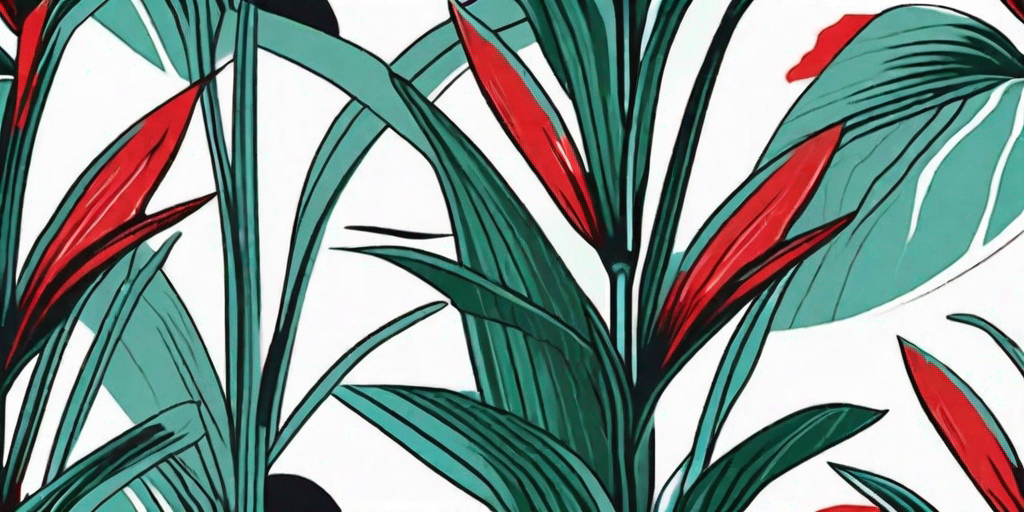
If you're looking for a houseplant that's as easy to care for as it is beautiful, look no further than the red-edged dracaena. This tropical beauty, with its striking red-edged leaves and tall, slender form, is a real showstopper. But don't be fooled by its exotic appearance - this plant is as hardy as they come, and with a little TLC, it can thrive in your home for years to come.
Understanding the Red-Edged Dracaena
Before we dive into the nitty-gritty of caring for this plant, let's take a moment to appreciate its natural beauty. The red-edged dracaena, also known as Dracaena marginata, is a member of the Asparagaceae family. It's native to Madagascar, but it's made itself at home in living rooms, offices, and conservatories around the world.
One of the most distinctive features of the red-edged dracaena is, of course, its red edges. The leaves are long, thin, and green in the middle, with a bright red or pink border. This gives the plant a fiery, dramatic look that's sure to turn heads.
Why Choose a Red-Edged Dracaena?
Aside from its stunning appearance, there are plenty of reasons to welcome a red-edged dracaena into your home. For starters, it's an excellent air purifier. According to NASA's Clean Air Study, the dracaena is one of the best plants for removing harmful toxins from the air. So not only will it beautify your space, but it'll also make it healthier!
Another reason to love the red-edged dracaena is its resilience. This plant is a real survivor, able to withstand less-than-ideal conditions like low light and irregular watering. So if you're a forgetful waterer or live in a home with limited natural light, this could be the perfect plant for you.
How to Grow and Care for Your Red-Edged Dracaena
Now that we've sung the praises of the red-edged dracaena, let's get down to business. How do you care for this fabulous plant? Don't worry, it's easier than you might think.
First things first, let's talk about light. Despite its tropical origins, the red-edged dracaena doesn't need a ton of sunlight. In fact, it prefers indirect light and can even tolerate some shade. However, too much direct sunlight can scorch the leaves, so be sure to keep it out of the path of harsh afternoon sun.
Watering and Feeding
When it comes to watering, less is more. The red-edged dracaena prefers to dry out between waterings, so be sure to let the top inch of soil dry before giving it a drink. Overwatering can lead to root rot, which is a surefire way to kill your plant. As for feeding, a balanced houseplant fertilizer every two weeks during the growing season (spring and summer) should do the trick.
One thing to note: the red-edged dracaena is sensitive to fluoride, which is commonly found in tap water. If you notice the tips of your plant's leaves turning brown, try switching to distilled or rainwater.
Pruning and Repotting
Pruning your red-edged dracaena will keep it looking its best. Simply cut off any yellow or brown leaves as they appear. If your plant gets too tall, you can also cut off the top to encourage bushier growth.
As for repotting, it's best to do this in the spring. The red-edged dracaena likes to be a bit root-bound, so only go up one pot size. Use a well-draining potting mix to prevent waterlogging.
Common Problems and How to Solve Them
Like all plants, the red-edged dracaena can encounter a few problems. But don't worry, most of them are easy to fix.
If you notice the leaves of your plant turning yellow, it could be a sign of overwatering. Cut back on the H2O and make sure your plant's pot has good drainage.
Brown leaf tips, on the other hand, could indicate a lack of humidity or exposure to cold drafts. Try misting your plant regularly or placing it on a tray of pebbles filled with water to increase humidity. And keep it away from cold windows or air conditioning vents.
Dealing with Pests
Unfortunately, the red-edged dracaena can sometimes attract pests like spider mites, scale, and mealybugs. If you notice small, discolored spots on the leaves or a sticky residue on the plant or surrounding surfaces, you might have a pest problem.
The good news is, these pests can usually be controlled with a mixture of water and mild dish soap. Simply spray the mixture on the affected areas and wipe clean. For more stubborn infestations, you might need to use a commercial insecticide or insecticidal soap.
FAQs
- Is the red-edged dracaena toxic to pets?
Yes, unfortunately, the red-edged dracaena is toxic to cats and dogs. If ingested, it can cause vomiting, loss of appetite, and excessive drooling. So it's best to keep this plant out of reach of your furry friends.
- How fast does the red-edged dracaena grow?
With the right care, the red-edged dracaena can grow up to 6-10 inches per year. However, growth can be slower in lower light conditions.
- Can I propagate the red-edged dracaena?
Yes, you can! Simply cut off a stem, let it dry for a day or two, then plant it in fresh potting soil. Keep the soil moist and in a few weeks, you should see new growth.
And there you have it, folks! Everything you need to know to grow and care for the stunning red-edged dracaena. With its striking looks and easy care, this plant is a true gem. So why not give it a try? Your home (and your lungs) will thank you!















